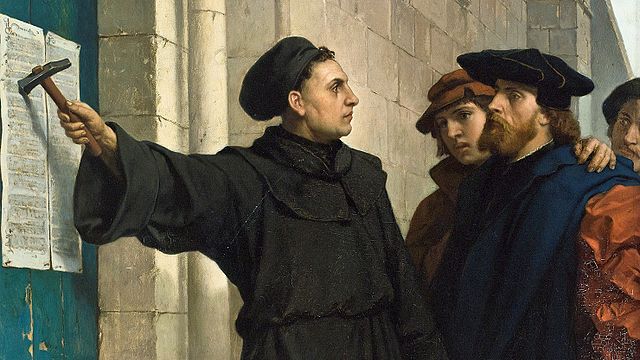
On October 31 parts of the western world celebrated Reformation Day, giving thanks for the Protestant Reformation. (I am tempted to observe that on the old Julian calendar, Reformation Day was on Thursday November 13.) Here I would like to look back and make a few observations about the accomplishments of the Reformation. For the Reformation resulted in a number of things we now too easily take for granted.
First of all, the Reformation brought to the fore the western doctrine of Purgatory. It is true that the Church, west and east, had always prayed for the souls of its departed members— a practice we see reflected as early as the teaching of St. Cyril of Jerusalem (d. 386) who observed that the Church prayed for its departed in the Eucharistic anaphora. In his Mystagogical Catecheses he said that “it will be a very great advantage to the souls for whom the supplication is made while the holy and most awe-inspiring Sacrifice is presented”. (See here for a more detailed look at Christian prayer for the dead.) But it is also true that a full-blown theology of Purgatory as a place of expiatory suffering to satisfy God’s justice as a prior condition for entry into heaven was late on the scene, arriving in the West in the latter part of the twelfth century. (See the Birth of Purgatory by Jacques Le Goff for the historical paperwork.)
Though the Orthodox pray for their devout dead, they do not accept the western doctrine of Purgatory or the classic theology that gave birth to it and in fact the doctrine was one of the “sticking points” between East and West at the Council of Florence in the mid-fifteenth century. Calling attention to the problematics of the doctrine which undergirded so much western spirituality and praxis was, to the Orthodox, a good thing.
Another accomplishment was the Reformation insistence that congregational worship be held in the vernacular. This was also the practice of the Orthodox Church (in principle anyway, though sometimes now not always in fact). There were historical reasons for this, including the multi-ethnic and multi-lingual nature of the Byzantine Empire. As Metropolitan Kallistos Ware wrote in his classic book The Orthodox Church, “In its services the Orthodox Church uses the language of the people: Arabic at Antioch, Finnish at Helsinki, Japanese at Tokyo, English (when required) at New York”. That was why the missionaries Cyril and Methodius who evangelized the Slavs worshipped with them in their native tongue, much to the distress of some in the West (though not the Pope!) who insisted that worship must be in Latin, Greek, or Hebrew. Orthodoxy has always taught (to quote a later writing) that “it is plainly repugnant to minister the sacraments in a tongue not understanded of the people” which is why Sts. Cyril and Methodius used the Slavic vernacular.
There were other accomplishments of the Reformation, ones less happy and fortunate.
One was the effective shattering of church unity in the West and, more importantly, the eventual re-ordering of thinking about church unity. Let’s jump into our time machine and try to understand what that unity was like prior to the Reformation.
Briefly, until the revolution wrought by Luther and his anti-papal friends (if you can call Zwingli Luther’s friend!) everyone thought that there was but one single Church, sacramentally united throughout the world by the inter-communion of its bishops. No one thought in terms of “churches” or “confessions” or “denominations”. There was no such thing as “Christianity” as an umbrella description covering all the varied confessions and churches. There was just the Church and all the Christians within it.
This was true even after 1054, a date more symbolic than useful. The year 1054 did not see the East and the West excommunicate each other or the creation of two separate churches, the Roman Catholic and the Eastern Orthodox. That date only saw the mutual excommunication of two bishops, the Pope and the Ecumenical Patriarch, both of whom had been feuding off and on for centuries. The estrangement of ecclesiastical West and East was much more gradual and incremental. The Fourth Crusade in 1204 (aka “the Western Sack of Constantinople”) increased the suspicion and hostility and did much to make the estrangement a visceral matter for the rank and file in the east. But even as late as the Council of Florence one could still consider the West-East quarrels something of an internal church matter. The East did not consider the West (whom they called “the Franks”) as a completely different church, only as erroneous and rather messed up. The Council was supposed to fix that. Sadly, it didn’t and East and West continued to live as married singles, living lives of ecclesiastical isolation.
That was pretty much how it stood in the early sixteenth century. The Church was still one, though everyone knew that the eastern churches had problems with some stuff in the West. What happened in 1517 is that the problems identified by a private member (i.e. Luther) came soon to be resolved by schism and not in the usual and historical manner of holding an ecumenical council.
It was the job of the bishops in council to identify problems and sort them out. And many of the bishops agreed that there were problems aplenty to fix. Even scholars like Erasmus were calling on the bishops to do their jobs and remedy what needed remedying. But Luther (and others, including those known to historians as “Anabaptists”) didn’t wait for the bishops but took matters into their own private hands. It was a bit like a vigilante taking things into his hands instead of resorting to the police and the courts.
Obviously, it was not simply a matter of German impatience. Doubtless Luther (who believed that the end of the world was at hand and that the Pope was the Antichrist) despaired of ecclesiastical solutions and concluded that independent action (i.e. schism) was the only way things could ever be fixed.
I suppose we will never know. When the western church did summon a council, the Reformation had separated half of Europe from the Catholic episcopate so that the council which met at Trent was severely reactionary. At Trent whatever savoured of the Reformation (such as a fresh look at Purgatory and the liturgical use of the vernacular) was off the conciliar table.
The main thing therefore that occurred in the West was the novel notion that a private individual (Luther, Zwingli, Calvin, Knox, whoever) could legitimately break away and start a new church. The new church might retain much from the old church from which he split away and value much from the ancient Fathers, but it was a new church nonetheless. This was not their intention— fixing the old Church was their intention. But it was the final result.
In other words, a new precedent was set and new methodology introduced. For if Luther could start a new church, then why couldn’t anyone do it too? And in the succeeding centuries, many, many people did. In fact, the multiplication of churches started in Luther’s lifetime.
The point is this: we now we take for granted the existence of a multitude of churches or “denominations” as perfectly normal. The notion of the Church being one fellowship scattered throughout the world and united in doctrine and bound together by sacramental hospitality has utterly vanished from public Christian consciousness. To be sure, “the Church” still exists as a theological construct or (as some call it) as “the invisible Church”, the sum total of all true Christians or of all the various denominations. But this is a far cry from the former notion of “the Church” being a visible and united sacramental fellowship led by bishops in communion with each other.
Admittedly groups like “the Plymouth Brethren” tried to protest this but so ingrained was it in Christian imagination and praxis that they simply became (perhaps to their horror) yet another denomination.
Another result of the Reformation was the centralizing and militarization of the western Catholic church. The anti-Reformation Council of Trent did its best to remedy some problems but its main goal was to stop the hemorrhaging of Catholics leaving their churches to become Protestant. The Catholic episcopate with the Pope at its head responded to the defections by battening down the hatches and doubling down on past customs. When half of Europe was shouting at them, it was hard to resist the temptation to shout back.
For example, sooner or later the Catholic west would’ve gotten around to using the vernacular in its liturgy; prior to the Reformation vernacular devotional primers for the literate were very popular. But the use of the vernacular as a badge of the Reformed movement made exclusive use of a liturgical vernacular anathema at Trent and delayed the use of the vernacular in the Catholic church for about four hundred years.
We ask: what other changes might have come in the Catholic west if things were allowed to proceed at their own pace apart from the Reformation? Would the papacy, swollen and corrupt in the sixteenth century, have reformed itself? Would the conciliar movement, once so important in the west, have revived so that the church possessed a less centralized papacy and a more independent episcopate? Would such a church at length have established a better working relationship with the Orthodox east and perhaps even overcome the east-west schism? Alas, we can never know.
What we can know is that the Reformation changed the world irrevocably, both for Protestants, Catholics, Orthodox, and for those of no faith at all. The modern world is the product of the Reformation and all that followed it, and of its dubious cousin, the (so-called) Enlightenment. Doubtless Luther, Calvin, and multitude of other Reformers did not foresee such a world. Their noble and sole goal was to help the western church of their time and give glory to God. But all actions have unforeseen consequences. That is why history, including church history, is so interesting— and not just on Reformation Day.
